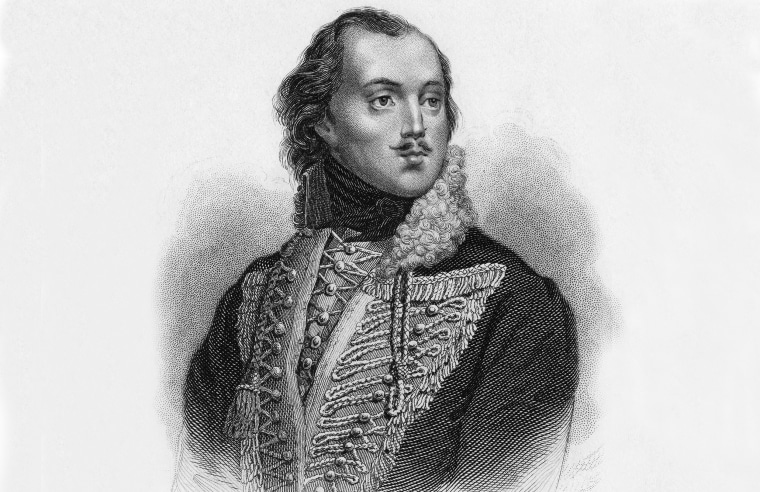Casimir Pulaski, hero of the Revolutionary War and the pride of the Polish-American community, may need a new pronoun — he may have been a she, or even a they.
Researchers who used DNA to identify Pulaski’s bones are convinced the gallant Pole who died fighting for America’s freedom was either a biological woman who lived as a man, or potentially was intersex, meaning a person whose body doesn’t fit the standard definitions of male or female.
That’s the eye-opening takeaway from a new Smithsonian Channel documentary titled “The General Was Female?,” which premieres Monday and is part of the “America’s Hidden Stories” series.
“One of the ways that male and female skeletons are different is the pelvis,” Virginia Hutton Estabrook, an assistant professor of anthropology at Georgia Southern University, told NBC News. “In females, the pelvic cavity has a more oval shape. It’s less heart-shaped than in the male pelvis. Pulaski’s looked very female.”
While the Pulaski skeleton showed tell-tale signs of extensive horseback riding and a battle wound on the right hand that the general is known to have suffered, the facial structure and jaw angle were decidedly female, Estabrook said.
Estabrook said her team is not the first to suspect that Pulaski might not have been a man. Others also noticed the delicate bone structure after the skeleton was extracted from the Pulaski monument in Savannah, Georgia. The general was only between 5-foot-2 and 5-foot-4 inches tall.
“Part of the reason it wasn’t more publicized at the time was that without DNA confirmation that this was Pulaski, it was easy to dismiss,” Estabrook said.
That changed after the team of scientists, that included Estabrook, were able to confirm that the bones were a match to DNA taken from Pulaski’s great niece.
Was Pulaski aware of being different from the men around him?
“Probably he was not completely aware,” Estabrook said. “What we do know about Pulaski is that there were enough androgens (male hormones) happening in the body, so that he had facial hair and male pattern baldness. Obviously, there was some genital development because we have his baptismal records and he was baptized as a son.”
But Pulaski never married. And while Pulaski’s letters reveal “he had a close relationship with a woman who ended up marrying a Polish prince,” it’s not clear whether there were any other women in his life.
“A lot of biographies play up that lost love romance angle,” Estabrook said.
What’s clear, Estabrook added, “is that he was a charismatic leader.”
“People seemed to be drawn to him and willing to give him power,” she said. “His letters reveal people in Congress were annoyed with him because he was super demanding. But they did seem to respect him. Clearly there was some flash and boldness about him that people responded to.”
Born in 1745, Pulaski was a member of the Polish nobility and a skilled cavalry officer who fought against the Russians when they tried to take over Poland. Pulaski fled to Paris when it was discovered that he had been part of a conspiracy to assassinate a puppet king imposed on Poland by Moscow.
There, Pulaski met Benjamin Franklin, who dispatched the young officer to the rebellious American colonies to join George Washington’s army.
Pulaski proved his — or her, or their — mettle in 1777 by preventing advancing British troops from capturing Washington at the Battle of Brandywine.
A grateful Washington made Pulaski a brigadier general and the Pole set about turning the Continental Army’s cavalry into a well-trained fighting force — despite the fact that Pulaski barely spoke any English.
“His letters to Congress demanding better resources for the cavalry, those were written in English,” Estabrook said. “He was working with a translator.”
Pulaski was just 34 when he was mortally wounded in 1779 while leading a cavalry charge at the Siege of Savannah. He was later dubbed the “father of the American cavalry.”
Since then, numerous towns, counties and schools have been named after Pulaski, along with important arteries such as the General Pulaski Skyway in New Jersey and the Pulaski Road in Chicago.
Polish-American police officers in New York City belong to The Pulaski Association.
And there’s also the Pulaski Day parade, which has been held annually since 1937 in New York City and follows the same route up Fifth Avenue as the St. Patrick’s Day parade.
Told of the revelations about Pulaski, Richard Zawisny, president of the annual Pulaski Day parade, admitted, "I'd heard something about this before, but I'm a little shocked by this."
"But in this day and age, I don't think it will matter to most people," he said. "I really believe that the majority won't care, and it doesn't take away from the fact that Pulaski was a Polish-American hero."

